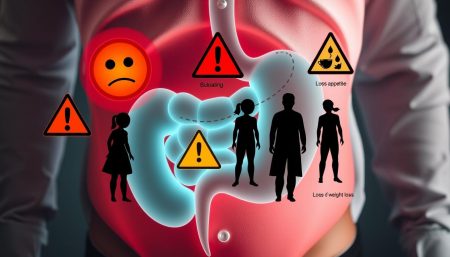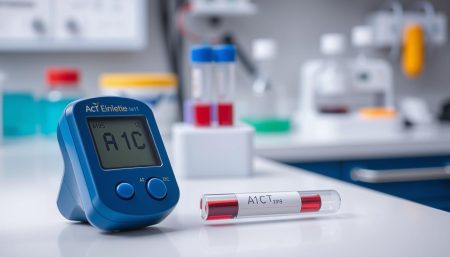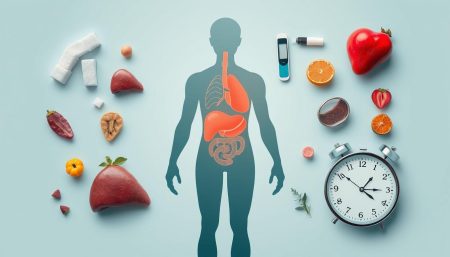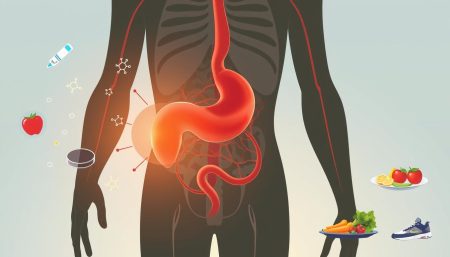The start of Type 2 diabetes can sneak up on you. It often feels like normal health issues that you might ignore. But, it’s key to spot the diabetes mellitus type 2 symptoms early. These signs are like your body’s alarm, telling you that blood sugar levels are not right.
Learning to recognize type 2 diabetes symptoms is important. It helps you get medical help quickly. This knowledge can lead to better health and avoid serious type 2 diabetes effects.
This article will explore the many symptoms of type 2 diabetes. Each one shows how our body reacts to high blood sugar. Remember, catching it early can change your life. It can make living with diabetes easier and keep you healthy.
Understanding Type 2 Diabetes and Its Impact on Health
Type 2 diabetes is a common chronic disease. It’s different from type 1 diabetes in how it develops and is managed. The type 2 diabetes manifestations and the effects of diabetes on health also vary.
Type 2 diabetes usually starts in adults. It happens when the body can’t use insulin well. This is unlike type 1 diabetes, which often starts in children and means the body can’t make insulin at all.
It’s important to know the difference between these two types. This knowledge helps both patients and doctors. It affects how the disease is managed and how it impacts health.
Not managing type 2 diabetes can lead to serious problems. It can harm many parts of the body.
- Cardiovascular Health: People with type 2 diabetes are at higher risk for heart diseases and stroke.
- Nerve Damage: High blood sugar can damage tiny blood vessels that feed your nerves, mainly in the legs.
- Kidney Damage: The kidneys have tiny blood vessel clusters that filter waste. Diabetes can harm this system.
- Eye Damage: Diabetes can cause serious eye problems, including blindness, diabetic retinopathy, cataracts, and glaucoma.
Managing type 2 diabetes is key. It can lessen the disease’s effects. Regular check-ups, blood glucose monitoring, and lifestyle changes can help.
Learning about type 2 diabetes is important. It helps people understand the risks of not treating it. This shows why it’s vital to take health seriously.
| Effect | Short-term Impact | Long-term Impact |
|---|---|---|
| Blood Sugar Levels | Hyperglycemia | Potential organ damage |
| Insulin Sensitivity | Decreased insulin efficacy | Increased health complications |
| Overall Health | Day-to-day management needs | Increased risk of systemic diseases |
It’s important to learn about type 2 diabetes manifestations and the effects of diabetes on health. This knowledge helps people manage their condition better. It improves their health outcomes.
Early Indications: Recognizing Diabetes Mellitus Type 2 Symptoms
Spotting early signs of type 2 diabetes is key to better health. Knowing these symptoms early helps manage the disease well. It’s important to notice these signs, from small changes to clear warnings.
The Onset of Persistent Thirst and Frequent Urination
Feeling thirsty all the time and needing to pee more often are common signs. This happens because your kidneys work hard to filter out extra sugar in your blood. If they can’t keep up, sugar goes into your urine, making you dehydrated and needing to pee more.
Unexplained Weight Loss and Increased Hunger
Loosing weight without trying could mean you have type 2 diabetes. When your body can’t use glucose for energy, it burns fat and muscle instead. This makes you hungry because your body can’t use the sugar from food.
Fatigue and Lethargy as Red Flags
Feeling tired and sluggish are big warning signs. They happen because your body’s glucose levels are off, making it hard to function. These symptoms are serious and can affect your daily life and well-being.
Knowing the early symptoms is critical in fighting type 2 diabetes. Early action and changes in lifestyle can help prevent serious problems.
Identifying Type 2 Diabetes Symptoms: A Closer Look
Watching for type 2 diabetes warning signs is key to catching it early. Many know about signs like drinking more water and needing to pee a lot. But there are other signs that are less obvious. This part talks about the different diabetes mellitus type 2 symptoms and why it’s important to keep an eye on your health.
Spotting diabetes means knowing about a variety of symptoms. For example, healing slower, mood swings, and skin or gum infections can hint at diabetes. These signs might not be obvious at first.
- Increased fatigue without obvious reason
- Visual disturbances that aren’t linked to known eye conditions
- Unexpected alterations in skin, like darkening around neck and armpits (Acanthosis nigricans)
- Persistent or recurring infections
It’s also important to know what increases the risk of getting type 2 diabetes. Things like family history and lifestyle choices can play a big role. Keeping an eye on blood sugar levels and talking to doctors when you notice something off is key to staying healthy.
Sometimes, symptoms don’t show up until they’re really bad. This is why regular check-ups and screenings are so important. It’s even more critical if you have a family history of diabetes or other risk factors like being overweight or having high blood pressure.
The table below lists both common and less known symptoms of type 2 diabetes. It gives a full picture to help catch and treat the disease early.
| Common Symptoms | Less Noted Symptoms |
|---|---|
| Increased thirst and urination | Mood changes |
| Unintended weight loss | Recurrent infections |
| Constant hunger | Skin conditions like Acanthosis nigricans |
| Fatigue | Slow healing of cuts and wounds |
Knowing all about diabetes mellitus type 2 symptoms helps people take care of their health. This knowledge lets people get medical help early. This can prevent serious health problems from diabetes.
Signs of Type 2 Diabetes: Beyond the Basics
As type 2 diabetes gets worse, several serious warning signs of type 2 diabetes may show up. These signs include vision problems, slow-healing sores, and numbness in the hands and feet. These signs are important for keeping your health in check over time.
Blurred Vision and Possible Eyesight Issues
Blurred vision is a common early sign of type 2 diabetes. It can really affect your daily life. High blood sugar can make the lenses in your eyes swell, causing blurry vision. But, this usually gets better once your blood sugar levels go back to normal.
Slow-Healing Sores and Frequent Infections
High blood sugar can slow down your body’s healing and immune system. This means cuts and wounds take longer to heal. It’s also a sign of diabetes if wounds don’t heal well. People with diabetes also get sick more often because their immune system isn’t as strong.
Tingling, Pain, or Numbness in the Hands/Feet
Peripheral neuropathy is nerve damage from high blood sugar. It causes tingling, pain, or numbness in your hands and feet. These feelings start at the tips and move up, showing serious nerve damage. It’s a clear sign you need to take care of your diabetes right away.
| Complication | Symptoms | Implications |
|---|---|---|
| Eye Complications | Blurred vision, difficulty focusing, occasional flashes of light | Can lead to permanent vision impairment without timely treatment |
| Wound Healing | Extended healing times, frequent infections | Increases risk of severe infections or complications like gangrene |
| Peripheral Neuropathy | Numbness, tingling, or pain in extremities | Can result in loss of limb function, decreased quality of life |
Physical Manifestations of Type 2 Diabetes on the Skin
Type 2 diabetes can show itself through certain skin conditions. These signs can help doctors catch diabetes early. A common sign is acanthosis nigricans, which looks like dark, velvety patches on the neck and armpits.
- Yellowish, scaly patches on the skin, known as necrobiosis lipoidica, which start as small raised solid bumps that develop into larger patches.
- Bacterial infections such as Staphylococcus aureus can cause boils or eyelid styes.
- Fungal infections like Candida albicans, which lead to rashes in moist areas of the skin.
These skin issues not only show diabetes but can also make it harder to manage. Spotting these signs early can help avoid bigger problems.
| Skin Condition | Appearance | Common Areas Affected |
|---|---|---|
| Acanthosis Nigricans | Dark, velvety skin patches | Neck, armpits |
| Necrobiosis Lipoidica | Yellowish, scaly patches | Lower legs |
| Staphylococcus Infections | Boils or eyelid styes | Various parts of the body |
| Candida Infections | Rash in moist areas | Skin folds, under breasts, around genitals |
Some signs, like itching or shin spots, might not seem serious at first. But it’s important to watch them. Taking care of these skin issues early can improve your life and prevent serious diabetes problems.
Systemic Effects of Type 2 Diabetes on the Body
Type 2 diabetes can harm many parts of the body over time. It’s important to know how it affects these areas to manage the disease well. This knowledge helps avoid serious health problems later on. We’ll look at how type 2 diabetes affects the heart, kidneys, and nerves.
Circulatory System Complications and Type 2 Diabetes
Type 2 diabetes can really hurt the heart and blood vessels. People with this disease often have high blood pressure and high cholesterol. These issues can cause heart attacks and strokes.
High blood sugar can also damage blood vessels. This makes it hard for blood to reach organs, leading to atherosclerosis.
Implications for Kidney Health and Function
Diabetic nephropathy is a serious kidney problem caused by type 2 diabetes. It makes the kidneys less able to filter waste. This can lead to a buildup of harmful substances in the body.
It’s key to catch this problem early and treat it to stop kidney disease from getting worse.
The Risk of Type 2 Diabetes on Nerve Damage (Neuropathy)
Neuropathy, or nerve damage, is another big problem with type 2 diabetes. High blood sugar can harm the nerves by damaging their blood supply. This can cause pain, tingling, and numbness, mainly in the hands and feet.
This can make everyday life harder by making it easier to get hurt or infected.
| System | Complication | Impact |
|---|---|---|
| Circulatory | Enhanced atherosclerosis, high blood pressure | Increased risk of heart disease and stroke |
| Kidney | Impaired filtration | Accumulation of bodily wastes; risk of kidney failure |
| Nervous | Nerve damage (Neuropathy) | Pain, infection risks due to loss of sensation |
Monitoring for Type 2 Diabetes Warning Signs
Managing type 2 diabetes starts with watching for symptoms closely. Create a type 2 diabetes symptoms checklist for yourself. Then, regularly monitor diabetes symptoms to keep your health in check and catch problems early.
- Keep a daily log of blood glucose readings to observe trends and variations.
- Regularly check and record blood pressure and cholesterol levels, as they can impact diabetes.
- Note any new or worsening symptoms in a health diary, such as increased fatigue or unusual weight changes.
- Use mobile health apps to remind you of medication times, track your diet, and log physical activity.
Also, having regular check-ups with your healthcare team is important. They can help update your type 2 diabetes symptoms checklist as your health changes. This ensures you’re considering all important health aspects.
Staying consistent with monitoring is essential for managing type 2 diabetes well. Use these tips to stay ahead in your health management journey.
Behavioral and Lifestyle Indicators of Type 2 Diabetes
Understanding the behavioral signs of type 2 diabetes is key to managing or preventing it. Lifestyle choices often play a big role in both causing and showing signs of diabetes. This makes studying them very important for those at risk.
The Influence of Diet and Exercise on Symptoms
Diet and exercise are major lifestyle indicators of diabetes. An unhealthy balance in these areas can raise your diabetes risk and worsen symptoms. Eating lots of fiber, whole grains, and greens, and avoiding processed sugars and fats can help prevent type 2 diabetes.
How Stress and Sleep Patterns Can Signal Diabetes Issues
Stress and irregular sleep are also big lifestyle indicators of diabetes. Chronic stress and poor sleep can mess with blood sugar and insulin levels. This is a warning sign for those watching out for behavioral signs of type 2 diabetes. Reducing stress with meditation or yoga and keeping a regular sleep schedule can help lessen diabetes symptoms or stop it from happening.
Choosing a healthier lifestyle can lower your diabetes risk and improve your overall health. It’s always a good time to start making changes that can greatly benefit your health.
Navigating Type 2 Diabetes Indicators as You Age
As people get older, finding and managing aging and type 2 diabetes symptoms becomes more important. Knowing the elderly diabetes signs can greatly improve life quality and health. It’s key to understand how these symptoms change with age to keep healthy and avoid problems.
Finding type 2 diabetes symptoms in the elderly can be tough because they often look like other aging issues. For example, feeling tired or less active might seem like just getting older, not diabetes. Here are some signs to watch for:
- Sudden or increased instances of confusion, often referred to as “diabetes-related dementia”
- Persistent fatigue not alleviated by rest
- Increased thirst and urination, which may escalate into dehydration if left unmonitored
- Unexplained weight changes, either gain or loss, without changes in diet or exercise routine
It’s important to keep an eye on these signs and adjust treatment plans as needed. Working with healthcare experts who focus on diabetes in older adults is helpful. They can make sure the specific needs of older adults with diabetes are met.
Being aware and taking action on aging and type 2 diabetes symptoms can greatly reduce their effects. This lets the elderly live a full and active life without severe diabetes problems.
Comprehending Serious Type 2 Diabetes Manifestations
It’s key to know the severe symptoms of type 2 diabetes to manage it well. This part talks about the serious and dangerous signs of type 2 diabetes. These include hyperglycemic crises and diabetic ketoacidosis, which are big diabetes problems.
Recognizing Hyperglycemic Crises
Hyperglycemic crises are urgent and need quick medical help. They happen when blood sugar gets too high. This can cause dehydration, confusion, and even coma if not treated fast.
The Danger of Developing Diabetic Ketoacidosis (DKA)
Diabetic Ketoacidosis (DKA) is a big worry for people with type 2 diabetes, mainly when they’re stressed or sick. It shows up with high ketones in the blood. Signs are nausea, vomiting, stomach pain, fast and deep breathing, and a sweet smell in the breath.
| Condition | Symptoms | Immediate Actions |
|---|---|---|
| Hyperglycemic Crisis | High blood sugar, dehydration, confusion | Seek emergency medical attention |
| Diabetic Ketoacidosis (DKA) | Nausea, rapid breathing, fruity breath | Immediate hospitalization |
The Importance of Regular Health Screenings for Type 2 Diabetes
Regular health screenings are key in stopping type 2 diabetes before it starts. These check-ups help find the disease early and start treatments that can change its course. By doing diabetes screenings, we can catch conditions before they turn into diabetes and keep our health on track.
Diabetes screenings use tests to check blood sugar levels and spot early signs of type 2 diabetes. Doctors suggest these tests for everyone, but they’re a must for those with a family history of diabetes, obesity, or high blood pressure.
Knowing about health changes can help prevent type 2 diabetes. For more on symptoms that mean you should get tested, read this article on early warning signs. Getting tested early can save your life.
| Screening Type | Description | Frequency |
|---|---|---|
| Fasting Plasma Glucose Test | Measures blood glucose after fasting | Annually |
| Hemoglobin A1c Test | Gives an average blood glucose level over the past 2 to 3 months | Bi-annually if at risk |
| Oral Glucose Tolerance Test | Measures body’s ability to use glucose | Initially as directed by a healthcare provider, then follow-up as necessary |
By adding these tests to your health routine, you help prevent type 2 diabetes. Understanding the importance of diabetes screenings and taking part in them can protect your health. It also encourages a healthier lifestyle, reducing the risk of diabetes problems later on.
Creating a Type 2 Diabetes Symptoms Checklist for Daily Monitoring
Managing type 2 diabetes starts with careful monitoring and self-care. A daily routine that tracks symptoms is key to avoiding complications. This approach helps catch health problems early and improves diabetes management.
Incorporating Blood Sugar Testing into Routine
Regular blood sugar tests are essential for managing type 2 diabetes. They show how well your diet and exercise are working. Here’s a simple checklist to make blood sugar testing a part of your day:
- Check blood glucose first thing in the morning to get your fasting sugar level.
- Test again before meals to help decide your food choices and portion sizes.
- Post-meal testing, typically two hours after eating, to assess how well your body is dealing with the intake.
- Perform a final test at bedtime to ensure levels are stable through the night.
Understanding HbA1c Levels and Their Importance
HbA1c tests show your average blood sugar levels over three months. They give a broader view than daily tests. This test is vital for managing diabetes over time.
Keeping HbA1c levels in check can lower the risk of serious problems like nerve damage and eye issues. It’s advised to have an HbA1c test every six months. If your levels are off or your treatment changes, you might need more tests.
Addressing and Managing Type 2 Diabetes Effects
Living with Type 2 diabetes can change many parts of your life. It’s important to know how to manage it. This includes taking medicine, changing your lifestyle, and getting regular check-ups. Thanks to new research, there are many ways to lessen the impact of Type 2 diabetes and improve your life.
Keeping your blood sugar levels in check is key. Medicines and insulin help a lot. But, what you eat and how much you move also matter a lot. Eating well and exercising can help control your blood sugar and lower risks. It’s also good to know how diabetes can affect your hair, like hair loss.
Making lifestyle changes is a big part of managing diabetes. This means watching your symptoms, eating healthy, exercising, and getting help when you need it. Doctors and nurses are there to teach you and help you make good choices for your health. With the right help, managing diabetes is possible and can make your life better.
FAQ
Q: What are the common symptoms and warning signs of type 2 diabetes?
A: Signs include feeling very thirsty and needing to pee a lot. You might also lose weight without trying, feel tired all the time, and feel very weak. These signs can mean you might have type 2 diabetes.
Q: How does type 2 diabetes impact overall health?
A: It can cause serious health problems like heart disease, kidney damage, and vision loss. It can also harm your nerves. Keeping your blood sugar in check is key to avoiding these issues.
Q: Why do people with type 2 diabetes experience increased hunger and weight loss?
A: Insulin resistance makes it hard for glucose to get into cells. This makes your body think it’s hungry, even when it’s not. It also makes your body burn fat for energy, leading to weight loss.
Q: What are some of the less common signs of type 2 diabetes?
A: Look out for dark skin patches, often in the neck or armpits. Also, watch for slow-healing wounds and infections. Blurred vision or tingling in your hands or feet can be signs too.
Q: What symptoms might indicate that type 2 diabetes is progressing?
A: Signs of worsening diabetes include blurred vision, slow-healing wounds, and nerve damage. These symptoms show that diabetes is not being well-managed.
Q: Are there specific skin-related symptoms of type 2 diabetes?
A: Yes, look out for velvety dark patches (acanthosis nigricans), yellow or brown skin patches (necrobiosis lipoidica), and itchy skin. Bacterial or fungal infections are also common.
Q: How can type 2 diabetes affect the circulatory system?
A: It can cause plaque buildup in blood vessels. This leads to poor circulation, blood clots, and high blood pressure. These issues increase the risk of heart disease and stroke.
Q: What can I do to monitor for type 2 diabetes warning signs?
A: Watch for symptoms like frequent urination, thirst, and sudden weight changes. Regular blood sugar tests and health check-ups are also important.
Q: How do diet and exercise influence symptoms of type 2 diabetes?
A: Eating right and staying active can help control blood sugar and weight. This can reduce some diabetes symptoms. A bad diet and not exercising can increase your risk of getting type 2 diabetes.
Q: What type 2 diabetes indicators should aging individuals be aware of?
A: Older adults should watch for typical diabetes symptoms and other age-related issues. These include managing blood sugar spikes, high blood pressure, and symptoms from other diseases.
Q: What are the signs of serious type 2 diabetes manifestations?
A: Severe symptoms include very high blood sugar, fruity-smelling breath, and confusion. These are signs of a medical emergency like diabetic ketoacidosis.
Q: Why are regular health screenings important for managing type 2 diabetes?
A: Screenings help catch diabetes early or manage it by checking blood sugar, HbA1c, and blood pressure. This leads to timely treatments.
Q: How should blood sugar testing be incorporated into daily monitoring?
A: Test your blood sugar regularly with a home monitor, as advised by your doctor. Keep a record to track any changes in your levels.
Q: What are HbA1c levels and why are they important?
A: HbA1c shows your average blood sugar over 2 to 3 months. It helps diagnose and monitor diabetes. Keeping HbA1c levels in check is key to avoiding complications.
Q: What strategies can help manage the effects of type 2 diabetes?
A: Managing diabetes involves lifestyle changes, like diet and exercise, sticking to medication, and monitoring blood sugar. Regular doctor visits and staying informed are also important.


















